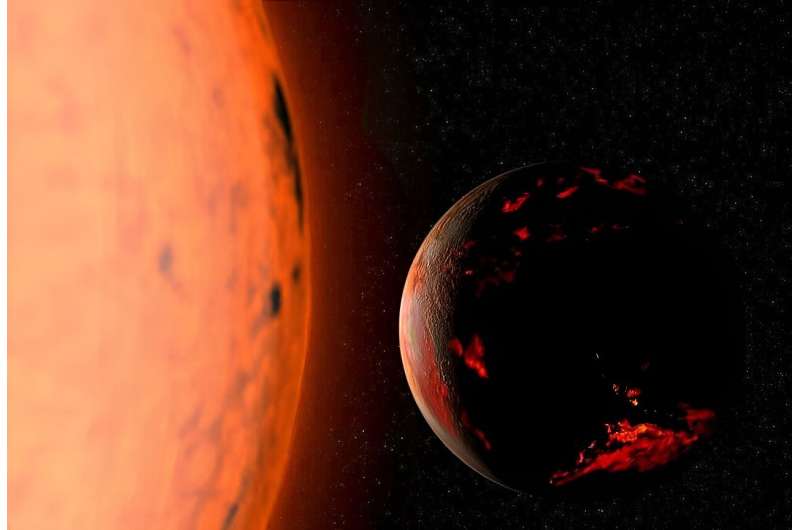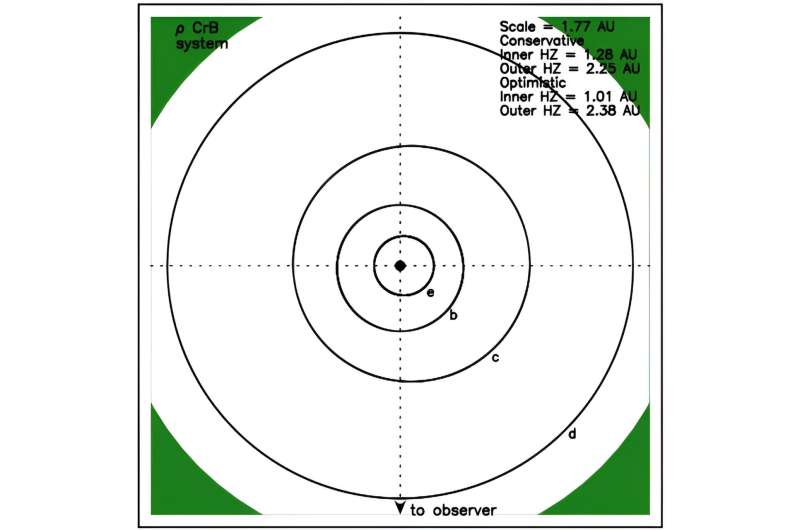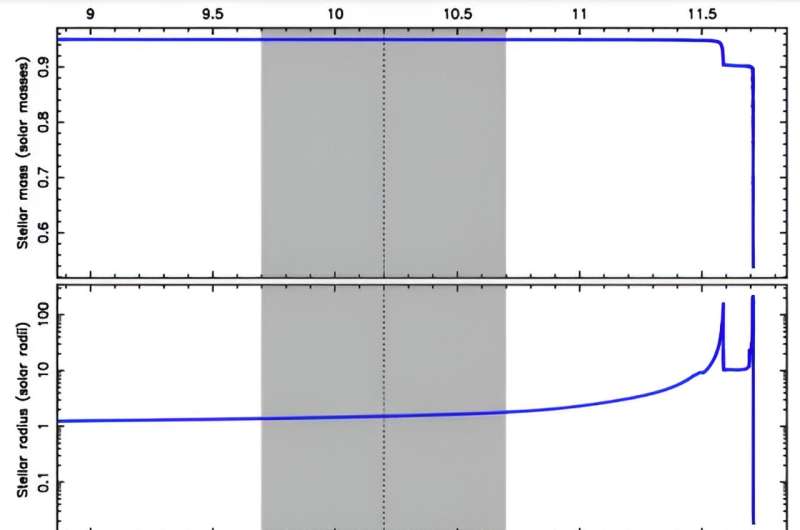This article has been reviewed according to Science X's editorial process and policies. Editors have highlighted the following attributes while ensuring the content's credibility:
fact-checked
peer-reviewed publication
trusted source
proofread
Three planets around this sun-like star are doomed

According to new research we can start writing the eulogy for four exoplanets around a sun-like star about 57 light years away. But there's no hurry; we have about 1 billion years before the star becomes a red giant and starts to consume them.
The star is Rho Coronae Borealis, a yellow dwarf star like our sun. It's in the constellation Corona Borealis, and has almost the same mass, radius, and luminosity as the sun. But where the sun is about five billion years old, RCB is twice that, which means its red giant phase is looming, at least in astrophysical terms.
A new paper posted to the arXiv pre-print server and accepted for publication in The Astrophysical Journal presents these results, and asks some questions about what happens to exoplanets in a star's habitable zone when the star becomes a red giant. The paper is titled "Planetary Engulfment Prognosis within the Rho CrB System," and the sole author is Stephen R. Kane, from the Department of Earth and Planetary Sciences, University of California, Riverside.
"Post main sequence stellar evolution can result in dramatic, and occasionally traumatic, alterations to the planetary system architecture, such as tidal disruption of planets and engulfment by the host star," Kane writes. Rho Coronae Borealis is both old and bright, making it "… a particularly interesting case of advanced main sequence evolution," according to Kane. Not only because its similar to the sun and easily observed, but also because it hosts four exoplanets.
Kane used stellar evolution models to try to determine Rho Coronae Borealis' future, and the future of its planets. In one to 1.5 billion years, the star will leave the main sequence and become a red giant. Red giants can swell to epic proportions, and some can expand to one billion km in diameter. When our sun becomes one in several billion years, it's bloated form will likely consume or at least destroy all of the inner planets.
Rho CrB is no different.
It has four known exoplanets named Rho Coronae Borealis b, c, d, and e. They're named in order of discovery, not distance from the star. The three planets in the most danger are e, b, and c, the closest planets to the star.
The four planets range in mass from super-Earth to Jovian. All of them are much closer to the star than Earth is to the sun, and the two innermost planets are closer to their star than Mercury is to the sun. They're tightly-packed into their inner solar system, and this is what spells their doom.
The research shows that e,b, and c are in the worst position. Rho CrB can totally engulf these three planets.
The engulfment of planets by an expanding star can have different outcomes depending on the overall architecture of the system. Planets can take decades to spiral in toward the star. On the way, they can be destroyed by evaporation. They can also destroyed by tidal disruption when they meet the Roche limit. In that case, they add to the star's bulk, helping it puff up even more.
For sub-Jupiter mass planets between 3 to 5 AU, their fate is sealed according to some research. There's no escape. But for others, despite the dire circumstances, there might be a way out.
Sometimes, scientific models show, planets start to interact in different ways gravitationally with one another as the star swells. As the star expands, it's also losing mass as it continues to fuse material. This creates tidal effects in the system, and in some cases, it can drive planets into mean motion resonances, and also drive them further from the star. So, there's a potential escape route. It's difficult to determine so far in advance what exactly might happen, though.

But if some do survive, researchers think they can survive as the star leaves the red giant branch (RGB) behind. They may even survive as the star enters the asymptotic giant branch (AGB) phase. The AGB phase is similar to the RGB phase, but RGB stars have slightly different chemistries in their cores and their shells. But the details of the star aren't that critical to the fate of the planets.
There's a possible escape route for some of the planets, but the same tidal interactions that can rescue a planet can also work against it. Interactions can drive a planet inward toward the star too, to an earlier demise. Researchers are actively trying to understand all of these process by watching stars that are leaving the main sequence.
To understand what might happen in the Rho CrB system, Kane plotted the star's future mass, luminosity, and radius.
Kane also plotted the changes the star will go through alongside the positions of the four exoplanets. That puts the peril the planets face in stark relief.
So how much detail can models and simulations provide when it comes to the specifics of Rho CrB and its planets?
"Although all of the planets will enter the stellar atmosphere of Rho CrB, their individual prognoses vary considerably," Kane explains.
Planet e, the innermost planet, is likely terrestrial. It'll be the first to go and will probably evaporate as the star engulfs it deeply. It's demise could be swift.
Planet b is the most massive of all four, at almost 350 Earth masses. It's more massive than Jupiter, and as it enters the star's expanding atmosphere, drag will cause it to in-spiral. Its fate is tidal disruption, as it simply won't be able to hang onto itself.
Planet b's fate can feed into planet c's fate. If planet b's material makes the star swell enough, that could hasten planet c's demise by engulfment. The same stellar swelling and radial expansion could also hasten planet d's demise by engulfment, all before the star leaves its RGB phase behind.
Planets c and d are both about Neptune-mass, and they would likely lose their mass by evaporation as they spiral in toward the star.
Unfortunately, the modeling did not account for orbital dynamics. But it's possible that one planet could escape all of this mayhem. Planet d is the lone world with a chance to escape. "Our model further did not include the effects of orbital dynamics, which has the potential to cause planet d to migrate further outward and possibly escape engulfment," Kane writes. If it does, it has a chance to survive for a lot longer, possibly in a newly established habitable zone.
That's possible, but not likely in this case. "Since the inner planets of Rho CrB are engulfed prior to the AGB phase, it is unlikely that orbital dynamics will play a major role in the system during and after the stellar mass loss," he writes.

There's no way to know for certain what will happen in this system. But astrophysicists are busy watching other solar systems for clues. There's not much observable evidence for engulfment so far, but that doesn't mean it's not happening.
"Thus far, observational evidence for planetary engulfment signatures has remained relatively sparse, suggesting that either engulfment scenarios are rarer than expected, or that signature detection is more challenging than anticipated," the paper states.
The detailed specifics of Rho CrB may be beyond our observational reach or the reach of our simulations and models, for now. But there's no denying the potential catastrophic consequences.
"The evolution of stars through their progression on the main sequence, expansion into a giant star, and then final contraction into a white dwarf, has profound consequences for the orbiting planets," Kane writes. "Given the masses and semimajor axes of the four known planets, we predict that planet e will evaporate within the stellar atmosphere, planet b will in-spiral and be tidally disrupted, potentially further inflating the star, and planet c will be evaporated within the stellar atmosphere."
Planet d's fate is a little less certain, but it'll likely be destroyed, too. It'll probably evaporate within the star at the end of the AGB phase.
It's possible that there are other planets within the habitable zone that haven't been detected. If there are, they can survive the stellar evolution on the inside of the HZ's inner edge during the RGB/AGB phase. But after that, the star will be a white dwarf. These planets, if they exist, will be well outside of the new HZ at that time.
Part of understanding what happens to solar systems when their stars leave the main sequence lies in an accurate picture of their planet populations. Giant planets on distant orbits can affect the fate of inner system planets, potentially changing their orbits and moving them to safer distances.
Those types of planets are difficult to detect with the transit method, but improved radial velocity measurements in the future could find more of them.
This research is particularly interesting because our own sun will become a red giant, and eventually a white dwarf. What will happen to our home?
It's not known, but the Earth is in jeopardy. It could be destroyed, or it could migrate further outward. Either way, our solar system will never look the same.
Fortunately, it's so far in the future that it's merely a curiosity to us.
More information: Stephen R. Kane, Planetary Engulfment Prognosis within the ρCrB System, arXiv (2023). DOI: 10.48550/arxiv.2310.16104
Journal information: Astrophysical Journal , arXiv
Provided by Universe Today





















